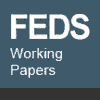
| Finance and Economics Discussion Series |
|---|
 |
Reading the Minds of Investors: An Empirical Term Structure Model for Policy Analysis Jim Clouse 2004-64 |
Abstract: Building on the recent macro finance literature, this paper develops an empirical term
structure model in which investors' judgmental forecasts of macro variables play an
important role. The model allows for a limited form of time-variation in the dynamics
describing the behavior of short-term interest rates and macro variables. As a result,
changes in economic forecasts over time reflect the influence of both economic shocks
and perceived changes in economic structure. The latter, in particular, are shown to be
important in explaining the evolution of the yield curve over time. An interest rate
accounting framework based on the model is applied in parsing changes in long-term
interest rates into portions associated with changes in term premiums and changes in
expected future short-rates. The changes in expected future short rates are then further
decomposed into portions attributable to changes in the expected future paths for
inflation, the unemployment rate, and GDP growth and also to a fourth factor interpreted
as changes in the "stance of monetary policy." The model results indicate that changes in
long-term interest rates, on average, have been about equal parts changes in term premia
and changes in expected future short rates. Changes in expected future short rates seem
to be driven largely by changes in the stance of monetary policy and in the outlook for
inflation while the estimated influence of changes in the outlook for the unemployment
rate and GDP growth is more muted.
Home | FEDS | List of 2004 FEDS papers
Accessibility
To comment on this site, please fill out our feedback form.
Last update: October 29, 2004